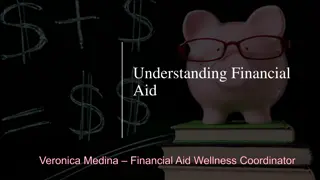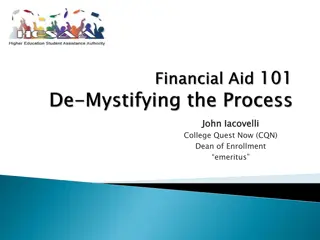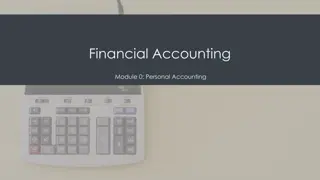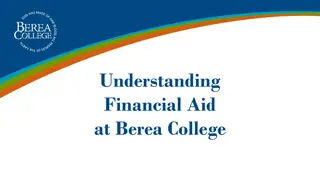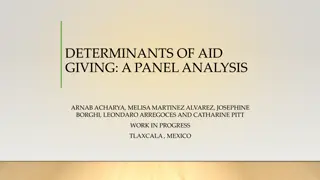Understanding Financial Aid for Higher Education
Financial aid for higher education is crucial for many students and families. This content covers the philosophy behind need-based financial aid, how need and aid are determined, types of financial aid available, and tips for applying for merit-based aid. It explains the calculation of financial need, the role of the Expected Family Contribution (EFC), and examples of financial need scenarios. Understanding this information is essential for navigating the complex world of college financing.
Download Presentation

Please find below an Image/Link to download the presentation.
The content on the website is provided AS IS for your information and personal use only. It may not be sold, licensed, or shared on other websites without obtaining consent from the author. Download presentation by click this link. If you encounter any issues during the download, it is possible that the publisher has removed the file from their server.
E N D
Presentation Transcript
University of Dayton Financial Aid 101 Office of Admission & Financial Aid Theresa Popelar
THE PHILOSOPHY OF NEED-BASED FINANCIAL AID It is the primary responsibility of the family to pay for higher education costs. Assistance from the federal government, state government, and individual institutions may be available when those resources are not sufficient. Financial aid is any resource provided to students and families to help pay for postsecondary educational expenses.
HOW NEED & AID ARE DETERMINED Cost of Attendance (COA) Cost of attending a particular school for one academic year Includes tuition, room & board, books, supplies, transportation, personal spending allowance, etc. Amount will vary from school to school Expected Family Contribution (EFC) Calculated by the Free Application for Federal Student Aid The EFC is the government s way of measuring your financial strength Amount your family is expected to contribute to your college education for one academic year The EFC is often more than most families feel they can afford EFC will be the same at every school
HOW NEED IS CALCULATED COA EFC _____________________________ = FINANCIAL NEED
FINANCIAL NEED EXAMPLES Private Public 2-Year COA $40,000 $20,000 $4,000 EFC ________________________________________ Need $30,000 $10,000 $10,000 $10,000 $10,000 -$6,000 (No need) what is used to award aid Some of your financial need may be met with merit or need-based aid. There may still be a balance after all financial aid has been applied.
TYPES OF FINANCIAL AID Merit-Based Aid Academic Scholarship Athletic Scholarship Leadership Scholarship Service Scholarship Talent Scholarship
APPLYING FOR MERIT-BASED AID Contact each college and university for their specific applications, deadlines and procedures for scholarships Ask your high school counselor about scholarships from local & regional sources Use online resources to locate scholarship opportunities and apply directly Some companies have scholarships available to children of employees
TYPES OF FINANCIAL AID Need-Based Aid Based on the Family s Calculated Financial Need Gift Aid Federal Grants Pell Grant, FSEOG, TEACH , etc. State Grants Ohio College Opportunity Grant, etc. Institutional Grants Self-help Aid: Federal Direct Student Loans (Stafford Loan Program) First-year loan limit: $5,500 regardless of income 2nd, 3rd, 4thyear limits Can be subsidized or unsubsidized Current interest rate of 4.53%, Origination fee 1.059% Interest rates are fixed for life of the loan Federal Work Study or University Funded Employment
OTHER TYPES OF FINANCIAL AID Federal PLUS Loan Loan in parent(s) name for undergraduate student Current interest rate of 7.08%, Origination fee: 4.236% Interest rates are fixed for life of the loan Eligibility based on credit check If parent is denied student is eligible to borrow $4,000 in additional unsubsidized federal direct loan STUDENTLOANS.GOV Private Student Loans Offered to students or parents from banks, credit unions, and private lenders Interest rates and loan terms vary Generally require a creditworthy co-signer for student to be the primary borrower on the loan
APPLYING FOR NEED-BASED AID Free Application for Federal Student Aid An application that collects demographic and financial information about the family and the student Families can file the FAFSA beginning Oct. 1 for the upcoming school year Must be completed each calendar year The FAFSA is free - you do not need to pay to complete it FAFSA.GOV CSS/Financial Aid PROFILE A supplemental aid application required by some colleges and universities to determine financial aid eligibility; contact each school before filing COLLEGEBOARD.ORG
FSA ID The FSA ID provides access to online Federal Student Aid systems and is your legal signature for the FAFSA Create your student and parent FSA IDs prior to completing the FAFSA Create your FSA ID at fsaid.ed.gov Tips Use name on Social Security Card! Parent and Student MUST use different email addresses Use email addresses that you ll always have - i.e. not a high school account that may be terminated Set Challenge Questions Easy to remember and won t change over time Store your information securely or use retrieval options if lost Tutorials on line or see studentaid.gov
SPECIAL CIRCUMSTANCES The FAFSA calculates EFC based on financial data from prior- prior year (ex: 2020-2021 FAFSA uses 2018 tax data) You may have special circumstances that may result in an EFC that does not reflect your family s current financial situation Common reasons include: loss of job, loss or death of a wage earner, medical or dental expenses not covered by insurance, change in marital status, or one-time payments from severance or retirement withdraw within the past calendar year Federal law allows each school to use professional judgment to evaluate these circumstances and potentially change your EFC and aid Schools are not required to accept special circumstances Each school will have varying documentation requirements
FINANCIAL AID SUMMARY Each school has their own deadline dates and requirements for scholarships and financial aid If you miss a deadline, you could miss out on aid Check with each school for necessary financial aid documents Your Student Aid Report from the FAFSA will indicate any additional federal requirements Once you have been accepted, each school will send you scholarship and financial aid information Compare each financial aid award you receive as well as the final, total costs of each school Some schools may assume loan borrowing when calculating costs Consider anticipated tuition increases, textbooks, and fees Make final decision by May 1, the national enrollment deadline
FAFSA ASSISTANCE IS AVAILABLE FAFSAhelpOH.org Contains calendar of FAFSA Completion Workshops around Ohio Website contains resources and links to answer questions and concerns about filing the FAFSA, including helpful videos Useful websites on the handout
THANK YOU! Questions? University of Dayton Office of Admission and Financial Aid 1-800-UD-PRIDE admission@udayton.edu
FREQUENTLY ASKED QUESTIONS When should I apply for financial aid? You should complete the FAFSA as soon as possible after October 1. Send results to every school to which you re applying. You will not be awarded aid until you ve been admitted. What tax data should I use in completing the FAFSA? If you are completing the FAFSA for the 2020-2021 school year, you would use 2018 tax information. If available, you should be able to use the IRS DRT in the FAFSA to electronically transfer your completed tax information into your FAFSA.
FREQUENTLY ASKED QUESTIONS What if my parents are divorced? If you re a dependent student, the parent with whom you lived the most with during the past 12 months must report their information on the FAFSA. If you lived with both parents equally, the parent who provided most of the financial support during the past 12 months must complete the FAFSA. My parents are divorced. I live with my mom and stepfather. Does my stepfather have to provide his income and tax information on the FAFSA? Yes, if you are a dependent student and live with a birth parent and stepparent, the stepparent s financial information must be reported on the FAFSA under the parental income section, even if they file taxes separately.
FREQUENTLY ASKED QUESTIONS I live with my aunt and uncle, rather than my parents. Should their financial information be reported on the FAFSA? Generally, no. You would report your birth or adoptive parents financial information. You would report on the FAFSA any cash support that you received from your aunt and uncle as untaxed income, excluding food and housing. If your aunt and uncle have legally adopted you, then you would report their information on the FAFSA. My parents do not believe I will qualify for any need-based aid. Why should I complete the FAFSA? You should complete the FAFSA, regardless of income level, because all students who complete the FAFSA are eligible for at least unsubsidized federal student loans. You may also be eligible for institutional aid, even if you re not eligible for federal or state aid. You also must complete the FAFSA in order to apply for the Federal PLUS Loan.
FREQUENTLY ASKED QUESTIONS What should I do if my family has unusual circumstances that the FAFSA does not account for? If you or your family experienced an unusual circumstance, complete the FASFA as is and then contact the financial aid office at the college you are attending or plan to attend and let them know of your special circumstance. You will need to provide documentation. How does a 529 savings plan affect my FAFSA results? If owned by either you or your parent(s), the value of a 529 will need to be reported under the parent asset section of the FAFSA if you are a dependent student. This has a relatively low impact on the EFC. If owned by a third party (i.e. a grandparent), the 529 value is reported as untaxed income for the student. This can have a high impact on the EFC.







